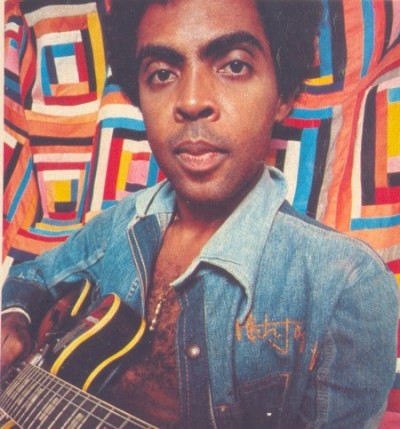Gilberto Gil is one of Brazil’s greatest living musicians-- a singer, songwriter and guitarist, who over the course of a long, prolific career has melded many different genres, including the Brazilian genres of baião, samba and the American and British psychedelic rock that caught the ears of many young Brazilians in the late 60s. As we are presenting a live concert that he performed in New York (and oh yeah, he's performing in NYC soon), we decided to take this opportunity to introduce readers who might be less familiar with his career to some outstanding highlights from his earlier years.
1) “Miserere Nobis” comes from the Tropicália: ou Panis et Circensis compilation that introduced the world to the Tropicália genre when it was released in 1968. A musical movement that was based around both a Brazilian take on psychedelia and a rebellion against Brazil’s military dictatorship, Tropicália was led by Gil, along with Gal Costa, Nara Leao, Os Mutantes, Caetano Veloso, and Tom Ze, who all also make appearances on the compilation. Both Gil and Veloso were imprisoned and forced into exile in the aftermath of the record, whose title is Latin for “Bread and Circuses,” a reference to the Brazilian politicians' handouts to the masses to distract them from the reality of their circumstances. “Miserere Nobis,” written by Gil, along with the poet José Carlos Captinam, also has a Latin title, which means “have mercy on us.” Starting with an organ intro, the song builds into a complex and catchy plea for the Brazilian people.
2) “Ele falava nisso todo dia” comes from Gil’s second solo record, Gilberto Gil (Frevo Rasgado). The song features orchestral arrangement from Gil’s longtime collaborator Rogério Duprat. Like “Miserere Nobis,” the song is an upbeat pop song with a strong social message about “uncertainty, poverty, bad luck.”
3) Gil released “Volks Volkswagen Blue” a year later on Gilberto Gil (Cérebro Eletrônico). More laidback than his songs of the previous year, the song is nevertheless more experimental, as Gil continually changes the song’s rhythmic feel, instrumental arrangement, and the pitch of his own voice, finally ending with trippy guitar distortion. Lyrically, Gil had transitioned from social commentary to some very groovy 60s imagery: “I’ve got the space under my skin/Such an idea thrills my soul/Breaks down my self control/But I feel like a yolk in a egg/On the way to the moon/Thrown high in the sky by my dream/In my Volkswagen blues.”
4) After a difficult period of exile in London, Gil was able to return to Brazil where he recorded one of his masterpieces, Expresso 2222. As the cover art of a small child (perhaps Gil himself?) indicates, the album returns Gil to his roots. “O Canto Da Ema” is a cover of a song written by the baião singer João do Valle, along with Aires Viana and Alventino Cavalcanti. Baião, a dance genre from Gil’s native Northeastern Brazil, originated with the area’s indigenous peoples, but also took influences from African and European styles.
5) “Ê, Povo, Ê” is, much like Refazenda’s album cover (a collage featuring Afro-tastic Gil sitting cross-legged and eating with chopsticks in his bathrobe), a light-hearted, fun song, featuring flutes, strings, horns and accordion, that might just make you start dancing in your bathrobe. Gil sings to the “people,” instructing them toward “good humor” and “dancing.” And you should listen to the man.








